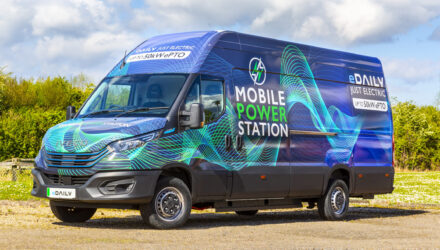With the 2035 petrol and diesel ban on the horizon, electric vehicles (EVs) are likely to become a normal occurrence across UK households and businesses. EV sales and registrations are already climbing year-on-year, with this forecasted to continue.
While EVs offer an opportunity to shift to cleaner transport for environmental reasons, Vehicle-to-Grid (V2G) charging could change the way organisations think about electricity.
With the first consumer V2G tariff announced last week, Adam Hall, Energy Services Director at Drax Electric Vehicles, explores the future of V2G charging and the opportunity it offers fleets.
What is V2G charging?
V2G is another phrase for bi-directional charging, the two-way flow of energy from the grid to vehicles and vice versa.
We’re in a transformative time where electric vehicles are integrating into our energy ecosystem. In one of National Grid’s Future Energy Scenarios, V2G charging could provide up to 38GW of flexible power from 5.5 million EVs. That extra electricity would cover all the extra peak power the UK needs in the highest-demand scenario for 2050.
At Drax Electric Vehicles, we see EVs as assets that can transform how organisations use energy and supercharge sustainability agendas through V2G technology. Historically, fleet vehicles have generated revenue only while operational. What V2G offers, in principle, is the opportunity for fleets to generate revenue in their downtime, too.
As EVs draw power from the UK energy network, they can also send power back if the grid needs it. This effectively means EVs can act like mobile power stations.
Renewable generation now makes up a greater share of the energy mix; the network has a higher percentage of clean and low-cost electricity available. It’s possible for EVs to act as stationary batteries, storing this power before sending it back to the grid. This means EVs can offer grid and energy price stability.
What could V2G mean for fleets?
Alongside wider electrification, we know that EVs will create extra demand for power. This rise in demand is likely to affect the price of electricity, but price volatility creates an opportunity for businesses to profit through optimising bi-directional V2G charging.
Most cars, including fleets, tend to be unused for over twelve hours a day. V2G technology means that fleets can charge when energy prices are low, either overnight or when there’s a surplus of renewable energy available on the network.
When the grid is under stress with high energy demand, a bi-directional charger can send power back to the network from fleet vehicles. Businesses may also be able to generate additional revenue by providing grid stability services, like V2G opportunities.
As an EV partner and energy supplier, we’re set up to provide EV charging, energy, and asset optimisation for businesses across the UK. With our EV insights, we can optimise fleets’ charging schedules, so you charge at the best time for the lowest cost. While our energy background enables us to explore the commercial viability of system stability services, like demand flexibility schemes and V2G technology.
How feasible is V2G technology?
Currently, bi-directional charge points are available but they’re not yet at a sufficient scale or an appropriate price to be viable. However, V2G technology will soon become more affordable, and organisations with EV fleets will be in a key position to benefit.
We’re helping organisations across the UK transition from internal combustion engine vehicles to EVs and develop a reliable, future-proofed electrification strategy. By trialling technologies like V2G, we’re beginning to understand how they can work in tandem and the future of commercial energy. Everything we learn will help us support businesses – now and in the future.
Author: Adam Hall, Energy Services Director at Drax Electric Vehicles


















